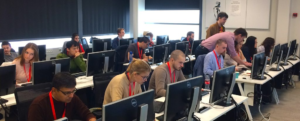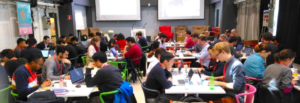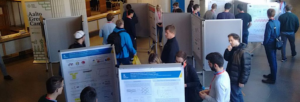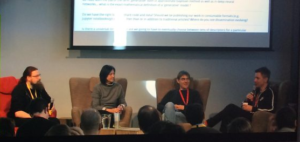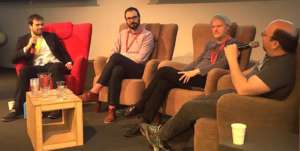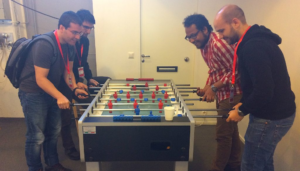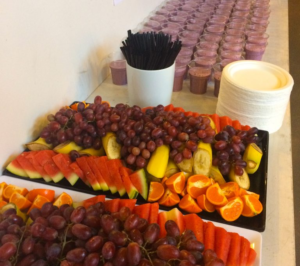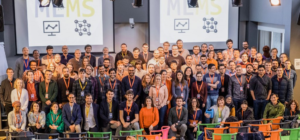The Young Researcher’s Workshop on Machine Learning for Material Science took place in the Aalto Design Factory, Espoo, Finland on date 06th-10th/05/2019. Workshop programme, abstract book, and workshop material (i.e. tutorial material, registration of talks and slides) for download can be found at https://ml4ms2019.aalto.fi/.
Below we resume the highlight of the event.
ML4MS SCHOOL
The first two days of the workshop involved introductory talks and a one-day long hands-on tutorial session. The aim of this initial workshop programme was to bestow the attendees with a pedagogical and practical introduction to the most established tools and techniques exploiting machine learning algorithms employed to solve outstanding problems in physical chemistry and chemical science.
On Monday, Dr. Luca Giringhelli introduced the attendees to the nuances of material space exploration via regularized and symbolic regression, together with a didactical intro on both supervised and unsupervised learning. The key role of descriptors that need to capture the complexity of the physical system under scrutiny was highlighted. A state of the art application to the agnostic and insightful classification of binary compounds was presented. The topics of open science, reproducibility and good use of repositories were also tackled in detail.
The next talk was carried out by Dr. Nongnuch Artrith. She discussed on the development of efficient and accurate artificial neural network potentials for the simulation of complex materials. Descriptors tailored for the use of neural networks for force field generation were examined in depth.
Successively a set of cutting-edge applications of neural network force fields for the study of heterogeneous catalysts and Li-based batteries were showcased.
On Tuesday the hands on session guided by Dr. Filippo Federici Canova foresaw a set of four tutorials covering the implementation and algorithmic aspects of four topics: materials descriptors, unsupervised learning and dimensionality reduction schemes, neural networks, and kernel ridge regression.
The hands-on session thus empowered the attendees with a practical set of tools introduced in the talks by Dr. Ghiringhelli and Dr. Artrith.
Photos taken during the hands on session. Webcast from the Finnish Centre for Computational Science was streamed to the ADF location and online.
In the morning of Wednesday, Prof. Michele Ceriotti introduced the use of machine learning methods to predict properties that do not transform as scalars. Commonly used descriptors employed in machine learning algorithms for material science were formalized, together with the introduction of a Dirac Notation as a tool to understand machine learning algorithms from a physical perspective. Examples of accurate and fast prediction for complex properties such as NMR spectra, response tensors and density fields were demonstrated.
Later, following the last-minute absence of Prof. Gabor Csanyi, two of the organizers, Claudio Zeni and Aldo Glielmo, introduced the audience to the use of Gaussian process regression for force fields generation. Their talk comprised a pedagogical introduction to regression and to development process of kernels for Gaussian regression that encode the physical symmetries relevant to the prediction of forces and energies. A discussion on how to speed up machine learning potentials via mapping procedure, with a paradigmatic example for the case study of the melting of a nanoparticle, was presented.
ML4MS WORKSHOP
The second part of the workshop foresaw the alternation of 14 invited talks and 12 contributed ones, together with two 1 hour panel-discussions. The aim of the workshop was to endow the young generation of researchers in the broad community of material science, condensed matter physics and biophysics with a comprehensive and exhaustive overview of the tools and techniques emerging in the rapidly developing field of machine learning applications to physical chemistry and chemical science. The wide community of attendees, also comprising mathematicians and computer scientists, nurtured cross-subject talks and interesting debates upon transferability of solutions to outstanding problems and challenges. Engagement of Industrial partners (IBM RXN LAB, IBM POWERAI LAB, NVIDIA, CURIOUS AI) further broadened the range of problems discussed. The fertile ground for learning from and interfacing with world leaders in the field was highly appreciated by the community together with the interdisciplinary range of topics covered during the talks and the panel discussion.
Wednesday
After the opening remarks by Dr. Milica Todorovic, the workshop began with two industry talks from IBM Labs. Philippe Schwaller discussed the latest development in the IBM RXN for Chemistry Lab, where a multi-head attention Molecular Transformer model was trained to predict Chemical Reactions, demonstrating a state-of-the-art 90% accuracy on common benchmark datasets, also outperforming the chemical intuition of human experts in the field. Jukka Remes from IBM PowerAI/Watson Machine Learning Accelerator Lab instead discussed the infrastructure for open source -based scalable and productive deep learning which has been latest developed in IBM.
The Bayesian afternoon session was then started by Prof. Antonietta Mira, which introduced the Bayesian formalism and a recent technique gaining momentum in several fields of statistics: Approximate Bayesian Computation. This is a likelihood-free algorithm used to carry on statistical inference where pseudo-data by forward-simulations can be generated. A set of multidisciplinary examples were then reported together with two examples related to the force-field calibration of TIP4P models for water and LJ potentials for He to match experimental data.
Lukas Hörmann followed by discussing the use of Bayesian linear regression to extract formation energies of different arrangements of molecules adsorbed on surfaces. molecule-molecule interactions were encoded in a feature space based on atom distances separating the contributions of various molecule-fragments to the total energy of the system. In a similar fashion, Jari Järvi discussed the use of Bayesian Optimization Structure Search for detecting Stable Surface Adsorbates for the case of conformers of C10H15O deposited on a Cu(111) surface.
During the Wednesday afternoon session, Michael Sluydts also discussed active learning strategies towards locating favourable point defects in silicon. He pointed out how the complex problem of searching for relevant configurations to train machine learning algorithms should be intelligently guided, e.g. by means of uncertainty estimates.
Finally, Prof. Teemu Roos provided an overview of the goals and achieved progress in the MachQu project, dedicated to the development of novel machine learning tools for quantum-mechanics based simulations. The example of neural network force fields for the case of damaged fusion reactors was showcased, together with the use of cross-entropy methods to account for uncertainty and drive active learning.
The day found its end with the conference dinner and poster session. Here participants had the opportunity to showcase their research and interact in an informal and relaxed atmosphere while profiting from the great oriental food catered in the main hall of the building.
Snapshot from the poster presentation.
Thursday
A generative model Thursday morning was bootstrapped by Volker Roth, introducing the audience to the topics of data topology and the use of deep latent variable models for exploring the chemical space of complex systems for an application in solar energy harvesting.
On a similar note Prof. Rafael Gomez-Bombarelli demonstrated the use of variational autoencoders in drug design and coarse graining model. The accurate instruction of the latent variable spaces of semi-supervised deep autoencoders were key in guiding the identification of optimal coarse graining functions and highly sought molecules.
In the same session Niko Oinonen reported on the development of a deep learning infrastructure to match AFM images with an unique descriptor that characterizes molecular configurations. The case study of 1S-camphor on Cu(111) was discussed bas on low-temperature AFM measurements.
Configurational sampling, in the context of global minimum searches, was also discussed by Jakub Kubečka. Heuristic swarm algorithms and machine learning were here demonstrated as a powerful set of tools to explore the energetic landscape of molecular clusters relevant in atmospheric physics.
High-throughput searches and the identification of physically informed descriptors to drive machine learning method for fast and accurate screening of materials were also touched upon in the Thursday morning session, as presented by Dr. Kamal Choudhary
Industry talks took place after lunch, where two leading Finnish companies, NVIDIA and CURIOUS AI discussed the application of Machine learning outside material science, in the paradigmatic cases of autonomous driving with deep learning (NVIDIA) and autonomous reasoning task via model based learning (CURIOUS AI)
Prof. Karsten W. Jacobsen took the baton of the generative models discussion and demonstrated their use in predicting material properties without knowing where the atoms are. Here text-based approaches were introduced to the audience with a state-of-the-art application in the case of perovskite materials for energy harvest.
Dr. James Cumby presented a discussion on the use of ellipsoids as a coordination descriptors, key to rationalize phase transitions also in the case of perovskites. Following the thorough discussion of several paradigmatic examples where this novel geometric descriptors proved to be powerful order parameter, Dr. James Cumby also resulted the winner of the Young Researcher’s award for best talk, sponsored by Wiley & Co.
The late afternoon was then taken over by the discussion of machine learning methods for material science applied in the context of many-body electronic structure problems
James Nelson discussed a methodology for utilising information from small cheaply calculated systems to predict quantities for larger systems using machine learning for the case of the prediction of the ground state energy and thermodynamic functions of the disordered one-dimensional Hubbard Model.
Jonathan Schmidt showed how automatic differentiation of modern machine-learning techniques can be exploited to develop a neural network functional for the exchange-correlation energy and the exchange-correlation potential of density functional theory, which achieves good accuracy and allows for flexibility by tuning its degree of locality.
Finally Prof. Thomas Hammerschmidt spoke on the use of machine learning descriptors based on the moments of the local electronic density of states of a material. Using the first four moments is sufficient to establish robust structure-energy relation In many crystalline and non-crystalline structures. Taking into account more moments leads to highly competitive descriptors for machine learning applications, as demonstrated in the recent NOMAD open challenge on transparent semiconductors.
Friday
A biophysics flavoured Friday morning started with the talks of Dr. Michele Allegra and Dr. Simon Olsson.
Dr. Michele Allegra presented the development of a simple and robust approach to cluster regions with the same local intrinsic dimensionality in a given data landscape. The paradigmatic example of folded vs unfolded configurations in a protein, as found in long molecular dynamics trajectories, was discussed.
Dr. Simon Olsson outlined recent advancements in the modelling of molecular kinetics using neural network strategies to parametrize coarse grain force fields, as well as in the use of augmented Markov models and dynamic graphic models to improve the accuracy and breadth of investigation of large molecular systems.
Neural networks for fitting coarse grained force fields for Li-batteries were also presented by Teo Lombardo in a talk covering aspects of Battery design and production from synthesis to deployment.
Neural network were the centrepiece of the discussion of Dr. Franco Pellegrini, who presented a Python code based on TensorFlow that supports local environment descriptors and training of feed forward neural network with species-resolved architectures and is patched with LAMMPS.
Before the final talk, Alessandro Lunghi discussed the combination of ridge regression and bi-spectrum components to describe the potential energy surface of molecular compounds in a very general fashion and with chemical accuracy (below 1 kcal/mol ).
The ML4MS workshop was then concluded by the talk of Prof. Olexandr Isayev presenting ANAKIN-ME, a novel method to train neural network potentials based upon single-atom atomic environment vectors, which allows for improved accuracy, high transferability and great speed. An example of its application was demonstrated for the case of simulations investigating explicitly solvated protein folding and carbon atom-growth patterns from the vapour phase.
Discussion sessions
Beyond scientific talks, a great length time was allowed for informal discussion among participants.
Furthermore, panel discussion enabled to recap the main themes tackled by the invited researchers in a more organic narrative, while also allowing for open debates on emerging research trends in the field.
Snapshot from the panel discussion
Finally, we would like to note that the Aalto Design Factory, with its latest era Finnish design and common spaces thought for all needs, together with the organic and healthy snacks provided by the workshop, allowed to offer each participant refreshment and entertainment also beyond scientific professional development.
example of the beyond science leasure at hands of the participants
Feedback
-) 100% of the participants reported a positive or highly positive feedback on the conference organization
-) 95% of the participants judged the participation to the conference as significantly or highly beneficial to its professional development
-) 95% of the participants appreciated the quality of the workshop facilities
-) 90 % of the participants also reported a good or great enjoyment of the workshop from a personal perspective
-) The transfer of knowledge was deemed successful, with 95% of the participants reporting to have learnt about new approaches of Machine learning in Material Science, 70% of them ready to apply this newly acquired knowledge to their current work, and 66% of them also engaging in implementing new Machine Learning approaches in Material Science.
-) Correspondingly, 95% of the students expressed a positive or very positive feedback on the introductory lectures and on the overall workshop programme.
-) A similar percentage also greatly enjoyed the poster session, with a majority of the participants also mentioning this workshop as a fantastic opportunity for networking, feedback, and establishment of new collaboration.
-) A large majority of attendees also significantly appreciated the gains from the hands-on computational tutorial session, with a compound positive or greatly positive feedback of 82%.
-) Circa two thirds of the attendees also profited greatly from the industry talks and panel discussion session, with another 20% of participants reporting a neutral judgement on these activities.
Though we are scientists, sometimes words speak even better than statistic, here we report feedbacks:
“The overall organization was super great. I personally liked a lot the panel session. As far as I am concerned is the time where I learned the most. Nice job with the poster session and the diversity of the topics. Hope in the future this will grow even more.”
“Very well organized, good information about the location and facilities. The workshop website was well designed and streaming the talks online was well executed.”
ML4MS final photo
Participant List
137 participants attended the event. 19 were invited speakers (4 of which from industry), 12 were young researcher contributed speakers, while 32 were poster contributors; 6 organizers topped up the other attendees.
A 1:4 ratio of female:male participants was observed. By the same token, circa one fifth of the attendees was affiliated with a Finnish Institution. The breakdown of attendees by countries than reports UK & Germany placing each around 13% of the registered participants. A similar percentage is observed for researchers affiliated with universities outside Europe. Other significantly represented countries were France, Italy, and Switzerland, while a remaining 20% of participants were conducting research in university and research centres in other European countries.
Live streaming of the talks reached up to 50 viewers at a time, with an average of 30 per talk.
A list of participants containing name, affiliation, country of origin can be found at the end of document.
NAME SURNAME AFFILIATION COUNTRY
|
Kim |
Nicoli |
Technische Universität Berlin |
Germany |
|
Laia |
Delgado Callicó |
King’s College London |
United Kingdom |
|
Teng |
Long |
TU Darmstadt |
Germany |
|
Danilo |
González Forero |
Universitat Autònoma de Barcelona |
Spain |
|
Joaquin |
Miranda Mena |
University of Bayreuth |
Mexico-Germany |
|
Nirmal |
Ganguli |
IISER Bhopal |
India |
|
Carsten |
Staacke |
TU Munich |
Germany |
|
Soumyajyoti |
Haldar |
University of Kiel |
Germany |
|
Hamidreza |
Hajiyani |
University of Duisburg Essen |
Germany |
|
Martin |
Deimel |
Technical University Munich |
Germany |
|
Juan Santiago |
Cingolani |
Technical University Munich |
Germany |
|
Sina |
Stocker |
Technical University Munich |
Germany |
|
Simon |
Wengert |
Technical University Munich |
Germany |
|
Henri |
Salmenjoki |
Aalto University |
Finland |
|
Murat Cihan |
Sorkun |
DIFFER |
Netherlands |
|
Abhishek |
Khetan |
DIFFER |
Netherlands |
|
Ali |
Hamedani |
University of Helsinki |
Finland |
|
Jesper |
Byggmästar |
University of Helsinki |
Finland |
|
Matteo |
Peluso |
Scuola Normale Superiore Pisa |
Italy |
|
Paola |
Torche |
University of Southampton |
United Kingdom |
|
Luca |
Bellucci |
CNR-NANO |
Italy |
|
Xiong |
Jingfang |
Xiamen University |
China |
|
Olga |
Miroshnichenko |
University of Oulu |
Finland |
|
Behnam |
Parsaeifard |
Basel University |
Switzerland |
|
Francesco |
Delfino |
First Moscow State Medical University |
Italy |
|
Štěpán |
Sršeň |
University of Chemistry and Technology Prague |
Czech Republic |
|
James |
Cumby |
University of Edinburgh |
United Kingdom |
|
Eamon |
McDermott |
Independent researcher |
Turkey |
|
Ilia |
Kichev |
Sofia University |
Bulgaria |
|
Steven |
Baksa |
Pennsylvania State University |
United States |
|
Vitus |
Besel |
University of Helsinki |
Finland |
|
Yihuang |
Xiong |
The Pennsylvania University |
United States |
|
Karen |
Dedecker |
Ghent University |
Belgium |
|
Rodrigo |
Pereira de Carvalho |
Uppsala University |
Sweden |
|
Andrea |
Silva |
University of Southampton |
United Kingdom |
|
Michiel |
Larmuseau |
Ghent University |
Belgium |
|
Sabine |
Matysik |
University of Cambridge |
United Kingdom |
|
Dominika |
Melicherová |
Comenius University in Bratislava |
Slovakia |
|
Hossein |
Kalashami |
University of Antwerp |
Belgium |
|
Huzaifa |
Shabbir |
University of Vienna |
Austria |
|
Mario |
Zauchner |
Imperial College London |
United Kingdom |
|
Michele |
Cutini |
University of Turin |
Italy |
|
Javier |
Heras-Domingo |
Universitat Autònoma de Barcelona |
Spain |
|
Ivan |
Yashchuk |
VTT, Aalto |
Finland |
|
Marie-Pierre |
Gaigeot |
Université d’Evry – Paris-Saclay |
France |
|
Daria Ruth |
Galimberti |
Université d’Evry – Paris Saclay |
Francia |
|
Sana |
Bougueroua |
université d’Evry – Paris Saclay |
France |
|
Lefteri |
Andritsos |
King’s College London |
United Kingdom |
|
Joakim |
Halldin Stenlid |
Stockholm University |
Sweden |
|
Yu |
Che |
University of Liverpool |
United Kingdom |
|
Joris |
Paret |
Université de Montpellier |
France |
|
Aurelia |
Li |
University of Cambridge |
United-Kingdom |
|
Marta |
Aragones-Anglada |
University of Cambridge |
United Kingdom |
|
Matthias |
Vandichel |
Aalto University |
Finland |
|
Kunal |
Ghosh |
Aalto University |
India |
|
Lincan |
Fang |
Aalto University |
Finland |
|
Vaiva |
Nagyte |
The University of Manchester |
United Kingdom |
|
Adam |
McSloy |
Warwick University |
United Kingdom |
|
Nurcin |
Ugur |
Aalto University |
Finland |
|
Lucy |
Whalley |
Imperial College London |
United Kingdom |
|
Diksha |
Dhawan |
University of Michigan |
United States |
|
Francesco |
Tavanti |
University of Modena and Reggio Emilia |
Italy |
|
Zahra |
Mohammadyarloo |
Aalto University |
Finland |
|
Jie |
Yao |
university of bayreuth |
germany |
|
Djordje |
Dangic |
Tyndall National Institute |
Ireland |
|
Arnab |
Majumdar |
Uppsala University |
Sweden |
|
Andrejs |
Cesnokovs |
Institute of Solid State Physics |
Latvia |
|
Maria |
Dimitrova |
University of Helsinki |
Finland |
|
Boris |
Dorado |
CEA |
France |
|
Andrea |
Sand |
University of Helsinki |
Finland |
|
Tao |
Jiang |
Ecole Normale Superieure de Lyon |
France |
|
Ekaterina |
Baibuz |
University of Helsinki |
Finland |
|
Kasun Kalhara |
Gunasooriya |
Ghent University |
Belgium |
|
Sophie |
Beck |
ETH Zurich |
Switzerland |
|
Kai |
Riedmiller |
University Konstanz |
Germany |
|
Yunpei |
Liu |
Xiamen University |
China |
|
Feiwu |
Zhang |
Chinese Academy of Sciences |
China |
|
Ygor |
Morais Jaques |
Aalto University |
Finland |
|
Rocio |
Bueno-Perez |
University of Cambridge |
United Kingdom |
|
Justin |
Villard |
Ecole Polytechnique Fédérale de Lausanne |
Switzerland |
|
Alexander |
Flachmüller |
University of Constance |
Germany |
|
Hanne |
Antila |
Max Planck Institute of Colloids and Interfaces |
Germany |
|
Tuomas |
Rossi |
Chalmers University of Technology |
Sweden |
|
Fabrizio |
Rovaris |
University of Milano-Bicocca |
Italia |
|
Ismail Can |
Oguz |
ICGM-MACS |
France |
|
Fedor |
Urtiev |
Aalto University |
Finland |
|
Niko |
Oinonen |
Aalto University |
Finland |
|
Eun-Ae |
Choi |
Korea Institute of Materials Science |
South Korea |
|
Annika |
Stuke |
Aalto University |
Finland |
|
Victor |
Claerbout |
Czech Technical University in Prague |
Czech Republic |
|
Susi |
Lehtola |
University of Helsinki |
Finland |
|
Usman |
Ahmed |
University of Helsinki |
Finland |
|
Mikael |
Johansson |
University of Helsinki |
Finland |
|
Lukas |
Wirz |
University of Helsinki |
Finland |
|
Francesco |
Marrafino |
University of Salerno |
Italy |
|
Anna Maria |
Nardiello |
University of Salerno |
Italy |
|
Kristoffer |
Simula |
Aalto University |
Finland |
|
Yashasvi |
Ranawat |
Aalto University |
Finland |
|
Marc |
Jäger |
Aalto University |
Finland |
|
Prokop |
Hapala |
Aalto University |
Finland |
|
Anja |
Aarva |
Aalto University |
Finland |
|
Anais |
Colibaba |
Trinity College Dublin |
Ireland |
|
Konstantin |
Karavaev |
NUST MISIS Moscow |
Russia |
|
Lauri |
Himanen |
Aalto University |
Finland |
|
Timo |
Roman |
Nvidia |
Finland |
|
Nongnuch |
Artrith |
Columbia University |
USA |
|
Philippe |
Schwaller |
IBM Research Zurich |
Switzerland |
|
Harri |
Valpola |
Curious AI |
Finland |
|
Simon |
Olsson |
FU Berlin |
Germany |
|
Thomas |
Hammerschmidt |
ICAMS, Ruhr University Bochum |
Germany |
|
Rafael |
Gomez-Bombarelli |
MIT DMSE |
United States |
|
Jukka |
Remes |
IBM |
Finland |
|
Olexandr |
Isayev |
University of North Carolina |
USA |
|
Karsten W. |
Jacobsen |
Technical University of Denmark |
Denmark |
|
Teemu |
Roos |
University of Helsinki |
Finland |
|
Michele |
Ceriotti |
EPFL |
Switzerland |
|
Luca |
Ghiringhelli |
FHI Berlin |
Germany |
|
Filippo federici |
Canova |
Nanolayers ltd |
Finland |
|
Volker |
Roth |
Basel University |
Switzerland |
|
Michele |
Allegra |
Aix Marsill |
France |
|
Antonietta |
Mira |
USI Lugano |
Switzerland |
|
Jari |
Järvi |
Aalto University |
Finland |
|
Franco |
Pellegrini |
SISSA |
Italy |
|
Lukas |
Hörmann |
Graz University of Technology |
Austria |
|
Kamal |
Choudhary |
National Institute of Standards and Technology |
United States |
|
James |
Nelson |
Trinity College Dublin |
Ireland |
|
Jonathan |
Schmidt |
Martin-Luther Universität Halle Wittenberg |
Germany |
|
Alessandro |
Lunghi |
Trinity College Dublin |
Ireland |
|
Jakub |
Kubecka |
University of Helsinki |
Finland |
|
Michael |
Sluydts |
Ghent University |
Belgium |
|
Teo |
Lombardo |
University of Picardie Jules Verne |
France |
|
Niko |
Oinonen |
Aalto University |
Finland |
|
James |
Cumby |
University of Edinburgh |
United Kingdom |
|
Aldo |
Glielmo |
King’s College London |
United Kingdom |
|
Claudio |
Zeni |
King’s College London |
United Kingdom |
|
Kevin |
Rossi |
EPFL |
Switzerland |
|
Patrick |
Rinke |
Aalto University |
Finland |
|
Adam |
Foster |
Aalto University |
Finland |
|
Milica |
Todorovic |
Aalto University |
Finland |

